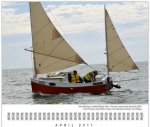dancrane
Well-known member
This is only a theory-query...nothing even on paper yet.
I know little about catboats, by which I mean cat-rigged boats, but I like their style and apparent simplicity.

I don't really know what defines them. Is a catboat's mast typically unstayed? (EDIT: I just noticed the forestay in the photo). Is that very difficult to engineer? How can an unstayed mast in a 20ft boat, be strong enough to carry 200+sq ft of sail?
My impression is that catboats are often wood, with wood masts...so the engineering that makes them possible, isn't new, and new materials might make retrofitting this pleasing rig to an old glassfibre boat, easier than crafting a new one from wood. Or, not.
To be honest I've been looking at a little old 19ft motorboat, with long shallow ballast keels and a tiny mast and sails for fun. It occurred to me that gaff rig might allow a much bigger sail area, kept low-aspect to match the shallow draft.
But I'd like to avoid increasing the length, such as a bowsprit would require to provide steering balance from headsails...so could a gaff catboat rig be drawn to keep the sail area low, and within the length on deck, as well as over the centre of lateral resistance?
If it influences anyone's answer, I had it in mind that the boat wouldn't be expected to make much (if any) upwind progress...
...she's basically a displacement motorboat anyway.
Thanks for any tips and thoughts.
I know little about catboats, by which I mean cat-rigged boats, but I like their style and apparent simplicity.

I don't really know what defines them. Is a catboat's mast typically unstayed? (EDIT: I just noticed the forestay in the photo). Is that very difficult to engineer? How can an unstayed mast in a 20ft boat, be strong enough to carry 200+sq ft of sail?
My impression is that catboats are often wood, with wood masts...so the engineering that makes them possible, isn't new, and new materials might make retrofitting this pleasing rig to an old glassfibre boat, easier than crafting a new one from wood. Or, not.
To be honest I've been looking at a little old 19ft motorboat, with long shallow ballast keels and a tiny mast and sails for fun. It occurred to me that gaff rig might allow a much bigger sail area, kept low-aspect to match the shallow draft.
But I'd like to avoid increasing the length, such as a bowsprit would require to provide steering balance from headsails...so could a gaff catboat rig be drawn to keep the sail area low, and within the length on deck, as well as over the centre of lateral resistance?
If it influences anyone's answer, I had it in mind that the boat wouldn't be expected to make much (if any) upwind progress...
...she's basically a displacement motorboat anyway.
Thanks for any tips and thoughts.
Last edited:







